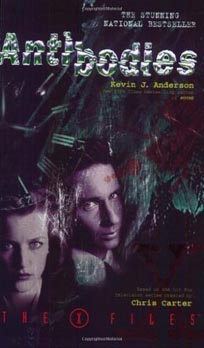Kevin J. Anderson’s trio of “X-Files” books ends on a weak note with “Antibodies” (1997). Despite having a core story that would make for a good monster-of-the-week episode, the narrative is thin, padded and sloppily structured. There’s enough decent stuff to make it worth reading for die-hard fans, but it’s clearly a step down from “Ground Zero” and “Ruins.” (Spoilers follow.)
Anderson tackles a sci-fi theme that was cutting edge at the time: nanotechnology. Genius scientist David Kennessy, of DyMar Laboratory in Oregon, perfects nanobots that he injects into his young son, Jody, curing his cancer. But adding dark undertones to this happy outcome are Jeremy Dorman, who injects himself with an older, unstable version of the nanobots to escape a fire at the lab that kills David; and Syndicate operative Adam Lentz, who aims to secure or destroy the technology.
For a deeper — and frankly, more entertaining — exploration of nanotechnology, check out Michael Crichton’s “Prey” (2002). “Antibodies” treats the subject in cartoony fashion. (Granted, the “X-Files” episode about nanobots, Season 6’s “S.R. 819,” also uses them as a mere plot device.) While Jody is completely cured, Dorman is a pain-wracked, mucus-covered blob who calls to mind Clayface from the “Batman” franchise. He could’ve been a sympathetic villain, but he’s both tiresome – it seems like the entire back half of the 268-page paperback finds him begging other characters for a sample of Jody’s blood so he can cure himself (which is a shaky proposition anyway, without a functioning lab) – and in fact evil, as we learn he was collaborating with Lentz, who then double-crossed him.
Anderson does come up with some scenes that would’ve had great shock value on the screen, like when Dorman shoots the Kennessys’ dog, Vader, to see if the nanotechnology injection will cure the canine. But the author just doesn’t have the scientific passion or knowledge to sustain his – or our – interest in the subject for the whole page count.
One positive note about “Antibodies” is that it syncs up with the TV show better than previous “X-Files” books did. In Season 4 (specifically in the famous post-Super Bowl episode “Leonard Betts”), which wrapped up before this book came out, Scully learns she has cancer. As such, she feels a particularly deep sense of protectiveness toward Jody. It’s similar to how she bonds with her would-be daughter Emily in Season 5’s “Christmas Carol”/“Emily,” and with a young cancer patient in “I Want to Believe.” (Oddly, the author doesn’t have Scully thinking about whether the nanotech could cure her. Through all three books, Anderson is gun-shy about getting into Mulder’s and Scully’s heads, perhaps fearing that he would contradict Chris Carter’s vision.)
Additionally, we learn in the closing pages that Lentz is working for the Cigarette-Smoking Man, who sees a cancer cure as a crucial playing card in his power game – if the Syndicate can’t have this miracle cure, he wants to make sure no one can. (Again, the author misses a chance to relate this case to the Cancer Man personally; although the CSM’s cancer wasn’t revealed at this point, we can assume that lung cancer would be a concern for someone who smokes non-stop.) In “Ruins,” Anderson hinted that the Syndicate had sent a covert military group to destroy a buried alien spaceship, but he didn’t say so outright. In “Antibodies,” he is willing to do so. Lentz, for his part, is somewhat of a replacement for Krycek, who had parted ways with the CSM by this point in the narrative.

It seems like Anderson wrote “Antibodies” more quickly than his previous two books. Not only is it obvious where the story is going, but it takes forever to get to the end. Entire sequences repeat themselves: Vader springs on Dorman to save Jody twice; and the dog makes a “shocking” recovery thanks to the nanobots no less than four times! It may be surprising to the characters, but not to us readers, as we are privy to the secret of the nanotech from the early going.
There is also a timing glitch. Mulder and an Oregon sheriff come upon a deceased trucker who was victim of Dorman’s plague. Then we cut to Lentz, back in Virginia, learning of the incident and deciding to fly out to Oregon. Then Lentz visits the scene. The time stamp says a few hours have passed, allowing for Lentz’s travels. But the sheriff notes that he had been at the scene for an hour, contradicting both the time stamp and the fact that Lentz flew out to the site.
This narrative glitch points to the fact that “Antibodies” is more of a rush job – both in the writing stage and the copy-editing stage — than the author’s first two “X-Files” books. While the concept of nanotech is worthy of the “X-Files” treatment, Anderson isn’t invested enough in it to create a meaty novel.

